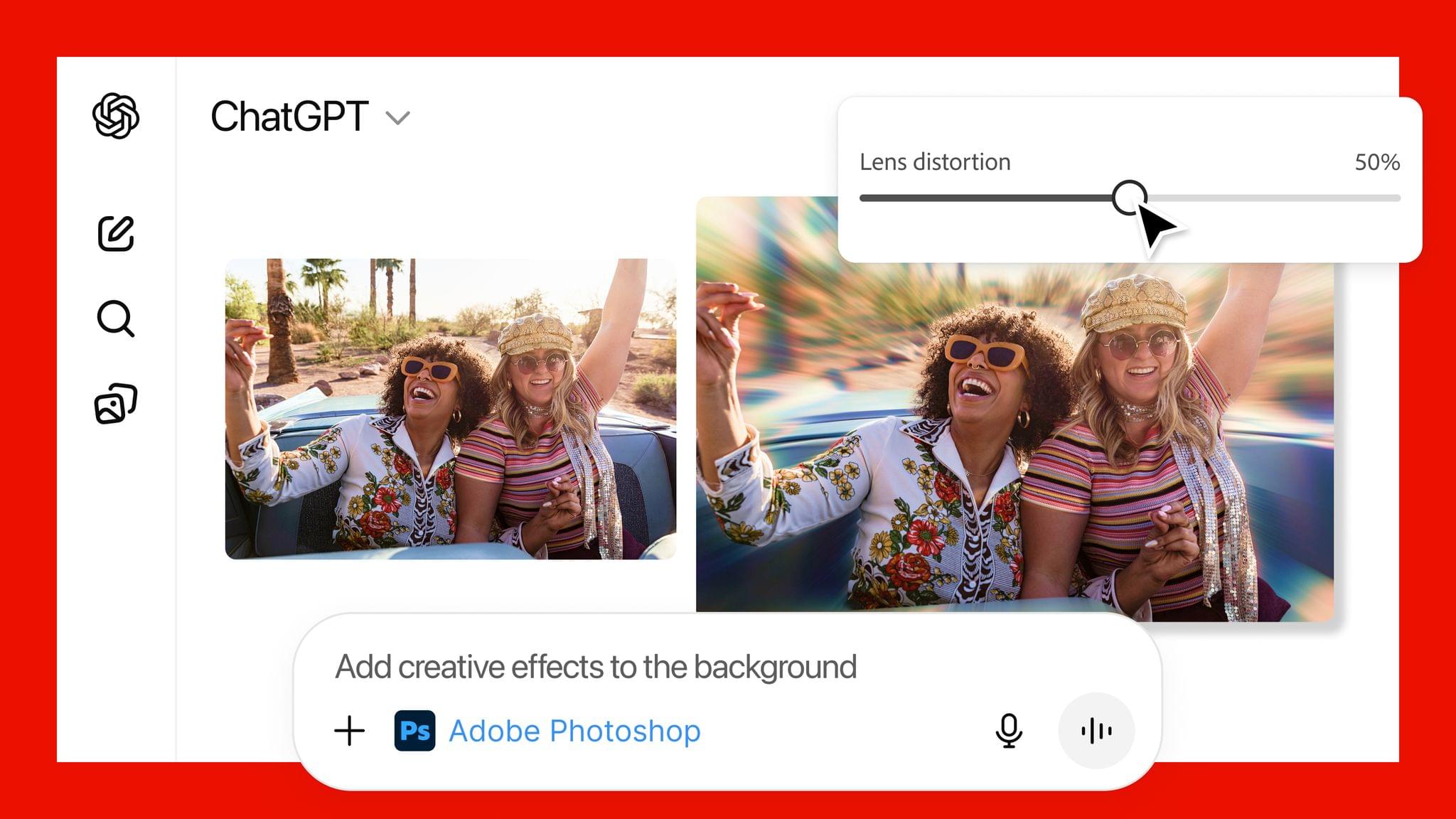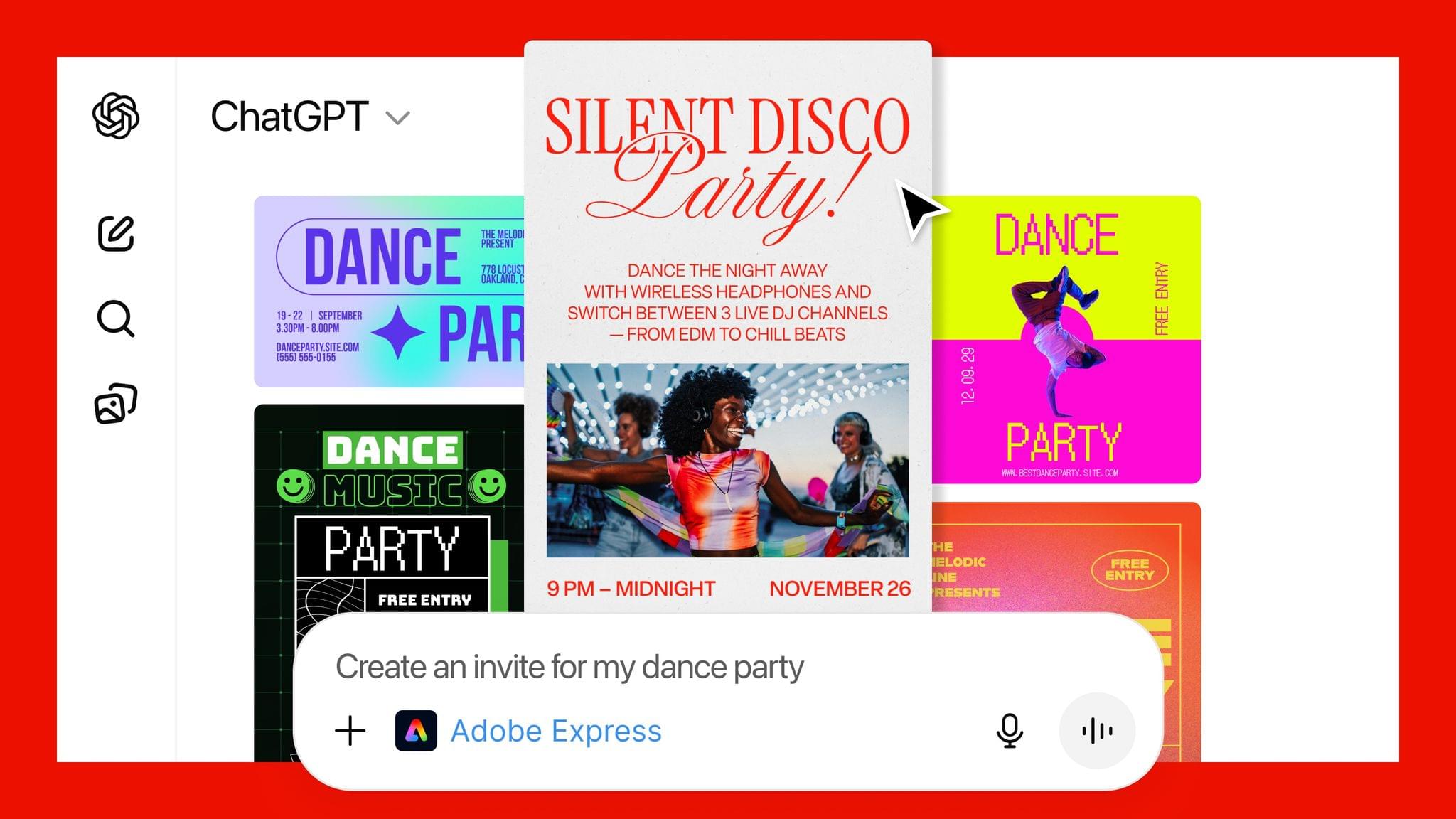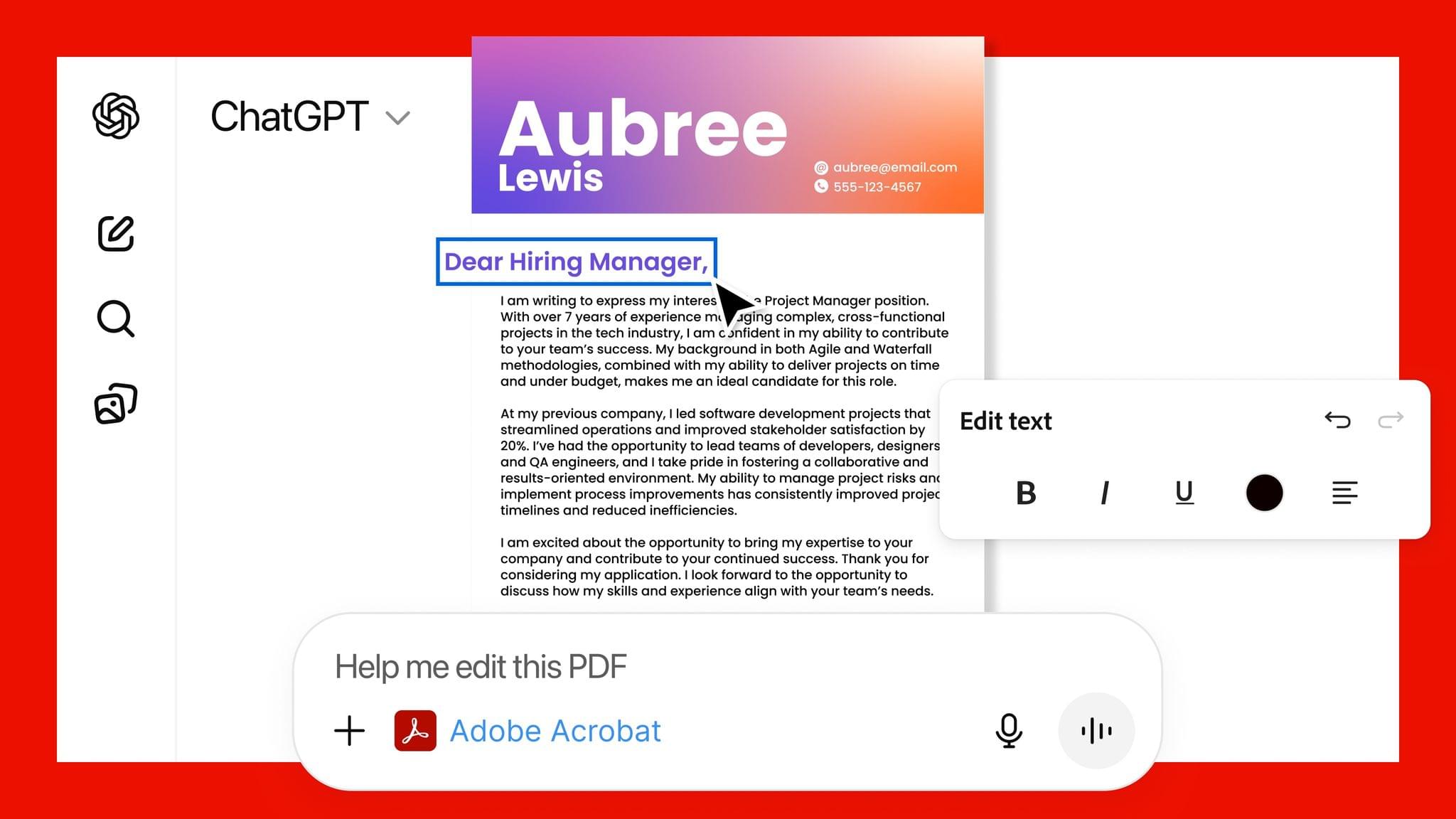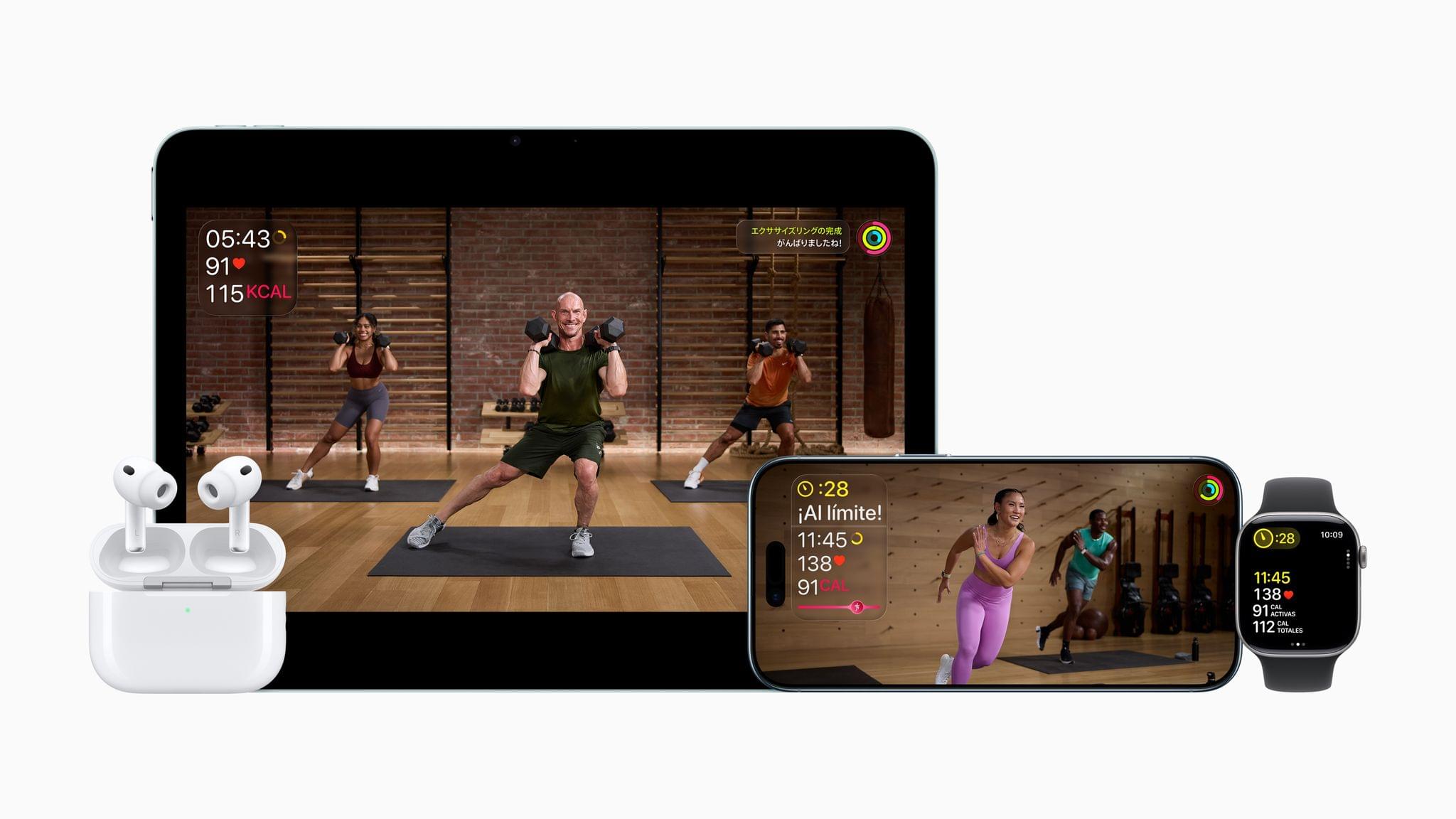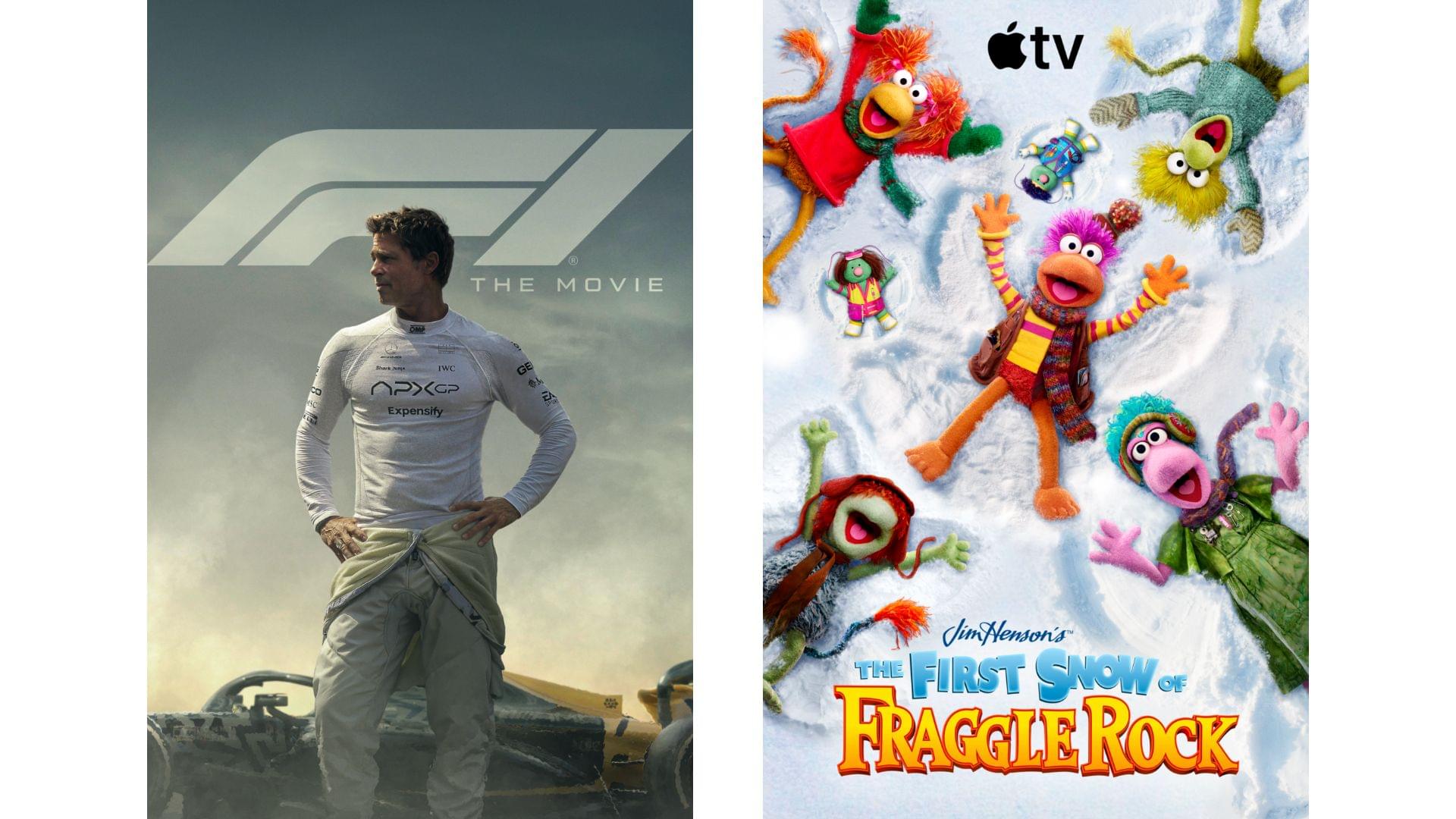Alyx is a new caffeine tracking app for the iPhone by Jordan Morgan that’s simple, fun, and flexible all at once. It’s a great example of marrying Apple’s latest design language with recent technologies in a way that serves its users incredibly well.
Adobe Announces Image and PDF Integration with ChatGPT
Adobe announced today that it has teamed up with OpenAI to give ChatGPT users access to Photoshop, Express, and Acrobat from inside the chatbot. The new integration is available starting today at no additional cost to ChatGPT users.
In a press release to Business Wire, Adobe explains that its three apps can be used by ChatGPT users to:
- Easily edit and uplevel images with Adobe Photoshop: Adjust a specific part of an image, fine tune image settings like brightness, contrast and exposure, and apply creative effects like Glitch and Glow – all while preserving the quality of the image.
- Create and personalize designs with Adobe Express: Browse Adobe Express’ extensive library of professional designs to find the best one for any moment, fill in the text, replace images, animate designs and iterate on edits – all directly inside the chat and without needing to switch to another app – to create standout content for any occasion.
- Transform and organize documents with Adobe Acrobat: Edit PDFs directly in the chat, extract text or tables, organize and merge multiple files, compress files and convert them to PDF while keeping formatting and quality intact. Acrobat for ChatGPT also enables people to easily redact sensitive details.
This strikes me as a savvy move by Adobe. Allowing users to request image and PDF edits and design documents with natural language prompts makes its tools more approachable. That could attract new users who later move to an Adobe subscription to get more control over their creations and Adobe’s other offerings.
From OpenAI’s standpoint, this is clearly a response to the consumer-facing Gemini features that Google has begun releasing, which include new image and video generation tools and reportedly caused Sam Altman to declare a “code red” inside the company. I understand the OpenAI freakout. Google has a huge user base and has been doing consumer products far longer than OpenAI, but I can’t say I’ve been very impressed with Gemini 3. Perhaps that’s simply because I don’t care for generative images and video, but these latest moves by Google and OpenAI make it clear that they see them as foundational to consumer-facing AI tools.
Activas: Modern Design with a Sprinkling of AI
Activas is a new health and wellness tracker for the iPhone and iPad from developer Brian Hough, who built it from the ground up with Apple Intelligence and Liquid Glass in mind. The app serves as a dashboard that brings together information from the Health app in a colorful and easy-to-understand way, using progressive disclosure to avoid overwhelming users with data. It’s a fantastic example of modern design that marries form and function to elevate the user experience.
The app has just two tabs that adopt iOS 26’s Liquid Glass design without sacrificing legibility. The default view is the Dashboard, which can display your recent health and wellness metrics for the last 7, 15, or 30 days. At the top of the Dashboard is a Momentum Score that’s calculated based on a composite of step count, sleep, resting heart rate, and BMI targets, plus your calorie goal. Unlike many similar apps, Activas links to research supporting its targets, which I appreciate. The Momentum Score and a handful of additional stats can also be tracked using one of the app’s Home Screen widgets.
The Momentum Score is followed by an AI-generated insight about your metrics. Because I haven’t been tracking my calories or weight recently, the app suggested I should. That’s followed by overviews of Activity, Nutrition, Sleep, Vitals, and Body Measurement. Each of these sections appears as a SwiftUI-style card that includes graphs showing recent trends, an insight about your metrics, and a suggested question that you can ask the Activas AI with a tap. Sections can be turned on and off and reordered in the app’s settings, too.
The Dashboard’s design is superb. By collecting individual measurements in groups of related statistics and providing a takeaway about each section, the app allows users to get a quick, understandable overview of where they’re succeeding and what needs work.
How Stu Maschwitz Vibe Coded His Way Into an App Rejection and What It Means for the Future of Apps→
This week on AppStories, Federico and I talked about the personal productivity tools we’ve built for ourselves using Claude. They’re hyper-specific scripts and plugins that aren’t likely to be useful to anyone but us, which is fine because that’s all they’re intended to be.
Stu Maschwitz took a different approach. He’s had a complex shortcut called Drinking Buddy for years that tracks alcohol consumption and calculates your Blood Alcohol Level using an established formula. But because he was butting up against the limits of what Shortcuts can do, he vibe coded an iOS version of Drinking Buddy.
Two things struck me about Maschwitz’s experience. First, the app he used to create Drinking Buddy for iOS was Bitrig, which Federico and I mentioned briefly on AppStories. His experience struck a chord with me:
It’s a bit like building an app by talking to a polite and well-meaning tech support agent on the phone — only their computer is down and they can’t test the app themselves.
But power through it, and you have an app.
That’s exactly how scripting with Claude feels. It compliments you on how smart you are, gets you 90% of the way to the finish line quickly, and then tortures you with the last 10%. That, in a nutshell, is coding with AI, at least for anyone with limited development skills, like myself.
But the second and more interesting lesson from Maschwitz’s post is what it portends for apps in general. App Review rejected Drinking Buddy’s Blood Alcohol Level calculation on the basis of Section 1.4, the Physical Harm rule.
Maschwitz appealed and was rejected, even though other Blood Alcohol Level apps are available on the App Store. However, instead of pushing the rejection with App Review further, Maschwitz turned to Lovable, another AI app creation tool, which generates web apps. With screenshots from his rejected iOS app and a detailed spec in hand, Maschwitz turned Drinking Buddy into a progressive web app.
Maschwitz’s experience is a great example of what we covered on AppStories. App creation tools, whether they generate native apps or web apps, are evolving rapidly. And, while they can be frustrating to use at times, are limited in what they can produce, and don’t solve a myriad of problems like customer support that we detail on AppStories, they’re getting better at code quickly. Whether you’re building for yourself, like we are at MacStories, or to share your ideas with others, like Stu Maschwitz, change is coming to apps. Some AI-generated apps will be offered in galleries inside the tools that created them, others will be designed for the web to avoid App Review, and some will likely live as perpetual TestFlight betas or scripts sitting on just one person’s computer, but regardless of the medium, bringing your ideas to life with code has never been more possible.
Apple’s Fitness+ Comes to New Countries and Gets New Language Support
On December 15, Apple is expanding Fitness+ to 28 new markets, including Chile, Hong Kong, India, Japan, the Netherlands, Singapore, and Taiwan, which will more than double the number of places with access to the service. The company is also dubbing fitness classes into Spanish, German, and Japanese, with the first two languages coming December 15, and Japanese dubbing coming early next year. K-Pop is being added as a new music genre to the service, too.
The dubbing of fitness classes into Spanish, German, and Japanese sounds like it’s using the same tech found in the Apple Watch’s Workout Buddy feature, which uses a generated voice based on existing instructors’ voices:
To help make Fitness+ even more welcoming to users around the world, the service is introducing digitally dubbed versions of workouts and meditations in Spanish and German, with Japanese dubbing to follow early next year alongside the availability of the service in Japan. The dubbed workouts and meditations feature a generated voice based on the actual voice of each of the 28 Fitness+ trainers.
I’ve been using Workout Buddy ever since watchOS 26 launched, and at least in English, the voices work well.
Last month, Mark Gurman wrote in his newsletter that Fitness+ was under review and might be folded into a broader health service. It may have been the case that the service was under review, but with the expansion into 49 total countries and the addition of new features, it appears that Apple has concluded Fitness is worth keeping as a standalone subscription.
Apple Announces That Kate Adams, Its General Counsel, and Lisa Jackson, Head of Environment, Policy, and Social Initiatives, Are Retiring
If you thought Apple’s leadership changes were finished, you’d be wrong. Today, the company announced two more changes.
The first change is to Apple’s General Counsel position, which has been led by Kate Adams since 2017. Adams will step down as general counsel on March 1, 2026 and will be replaced by Jennifer Newstead, Meta’s recent general counsel. Newstead will begin her tenure at Apple at the beginning of 2026 as a senior vice president and report to Tim Cook.
The second change is that Lisa Jackson, Apple’s vice president for Environment, Policy, and Social Initiatives is retiring in late January 2026. Under her leadership, Apple says it has reduced its global greenhouse emissions by 60% in the past ten years. Upon Jackson’s retirement, Government Affairs will be handled by Adams who will be staying at Apple until late 2026 when she plans to retire herself, at which point Government Affairs will become Newstead’s responsibility. The team handling Environmental and Social Initiatives will report to Sabih Khan, Apple’s chief operating officer.
Although Apple doesn’t say so in its press release, it’s pretty clear that a few things are playing out among its executive ranks. First, a large number of them are approaching retirement age, and Apple is transitioning and changing roles internally to account for those who are retiring. Second, the company is dealing with departures like Alan Dye’s and what appears to be the less-than-voluntary retirement of John Giannandrea. Finally, the company is reducing the number of Tim Cook’s direct reports, which is undoubtedly to simplify the transition to a new CEO in the relatively near future.
2025 App Store Award Winners Revealed
From a pool of 45 finalists, Apple has named 17 App Store Award winners comprised of apps and games across all of its platforms. This year’s App Store Award honors were presented to:
Apps
iPhone App of the Year: Tiimo from tiimo.
iPad App of the Year: Detail from Detail Technologies B.V.
Mac App of the Year: Essayist from Essayist Software Inc.
Apple Vision Pro App of the Year: Explore POV by James Hustler.
Apple Watch App of the Year: Strava from Strava, Inc.
Apple TV App of the Year: HBO Max from WarnerMedia Global Digital Services, LLC.
Games
iPhone Game of the Year: Pokémon TCG Pocket from The Pokemon Company.
iPad Game of the Year: DREDGE from Black Salt Games.
Mac Game of the Year: Cyberpunk 2077: Ultimate Edition from CD PROJEKT S.A.
Apple Vision Pro Game of the Year: Porta Nubi by Michael Temper.
Apple Arcade Game of the Year: WHAT THE CLASH? from Triband ApS.
Cultural Impact
Art of Fauna by Klemens Strasser
Chants of Sennaar from Playdigious
despelote from Panic, Inc.
Be My Eyes from Be My Eyes
Focus Friend by Hank Green from B-Tech Consulting Group LLC
StoryGraph from The StoryGraph
Tim Cook had this to say about the winners and their apps:
Every year, we’re inspired by the ways developers turn their best ideas into innovative experiences that enrich people’s lives. This year’s winners represent the creativity and excellence that define the App Store, and they demonstrate the meaningful impact that world-class apps and games have on people everywhere.
This year’s list of App Store winners is one of my favorites for a bunch of reasons. There are excellent games ranging from Art of Fauna by indie developer Klemens Strasser to Cyberpunk 2077 by CD PROJEKT S.A., as well as other great titles like despelote, which was published by our friends at Panic, Chants of Sennaar, and DREDGE, whose creators Federico and I interviewed at WWDC this year. There were other excellent apps, too, like Essayist, the academic-focused word processor.
Of course, my favorite app among the bunch is Detail, this year’s iPad App of the Year. Yes, I’m hopelessly biased because my son Finn is part of the team that built the app. But it’s also a great example of an app that lowers the barriers to creativity by leveraging Apple’s hardware in a unique way.
Congratulations to all of this year’s App Store Award winners. Of all the apps on the App Store, it’s quite an honor to be among the 17 apps recognized by Apple’s editorial team.
Finally, the year-end award season isn’t over. We’ll be presenting the 2025 MacStories Selects Awards later this month, so keep an eye out for more award-winning app coverage from us.
Coming Soon: What’s Next on Apple TV and Apple Arcade in December 2025
This month is a relatively quiet one for Apple TV, but there are a few gems coming soon, and Apple Arcade has a bunch of new games that are out tomorrow, so let’s dig into the highlights of both.
Apple Arcade Games (December 4)
Apple Arcade is kicking things off this month with four new games:
This sequel to the popular platformer SpongeBob: Patty Pursuit is filled with the same colorful mayhem as its predecessor.
I was pretty excited to see PowerWash Simulator coming to Apple Arcade. I know a lot of people find these types of simulator games relaxing, but I’ve never tried one, so I think I’ll dip into PowerWash over the holidays.
Cult of the Lamb Arcade Edition
Cult of the Lamb is a great roguelite from Massive Monster that was originally published by Devolver Digital in 2022 and is coming to Apple Arcade. According to Apple’s press release:
This version includes exclusive content, including new follower forms, decorations, and outfits, along with all existing content updates and paid packs.
If you haven’t played it yet, be sure to check out Cult of the Lamb. It’s a game I have returned to several times since its initial release, and I expect it will do well on Apple platforms.
Subway Surfers is an App Store classic that remains popular more than a decade after its original release. With the plus version on Arcade, subscribers can enjoy the game uninterrupted by ads or in-app purchases.
NARUTO: Ultimate Ninja STORM+ originally debuted on the Sony PS3 and was later ported to other platforms including mobile phones. On iOS, the 3D arena fighting game that’s based on a manga and anime series was available as a paid upfront game. With the plus version, there’s no upfront cost beyond a subscription to Apple Arcade, and the game adds new characters and a new stage.
The First Snow of Fraggle Rock (December 5)
The holiday season is upon us, and Apple TV is kicking things off on Friday with The First Snow of Fraggle Rock, featuring the characters from the Apple TV series.
Add to your Calendar:
F1: The Movie (December 12)
The biggest event of December for Apple TV is the streaming debut of F1: The Movie. The film has been available to buy or rent for a while after playing in theaters last summer, and now it will be available to stream as part of an Apple TV subscription, too. I haven’t seen F1 since WWDC in June, so I’m looking forward to rewatching it with my family over the holidays.
Add to your Calendar:
Bloomberg Reports That Alan Dye Is Leaving Apple
Mark Gurman, writing for Bloomberg, reports that Alan Dye, Apple vice president of Human Interface Design, is leaving the company to head up Meta’s design team. Dye’s departure was confirmed by Apple to Bloomberg, with Apple CEO Tim Cook telling the publication that Steve Lemay will take over Dye’s role:
Steve Lemay has played a key role in the design of every major Apple interface since 1999. He has always set an extraordinarily high bar for excellence and embodies Apple’s culture of collaboration and creativity.
Dye, who led the rollout of Apple’s Liquid Glass design language across all of its OSes, will be in charge of hardware, software, and AI across Meta’s product lines. Billy Sorrentino, who worked with Dye, is also leaving Apple’s design group for Meta.
Dye’s departure comes at an interesting moment for Apple and Meta. Meta, which has seen some success with its Ray-Ban smart glasses, has struggled with other consumer product projects but clearly wants to do more with AI-infused hardware. Meanwhile, Apple has had trouble infusing its software and hardware lineup with AI and has experienced a rash of departures among its AI team and retirements within its executive ranks. 2026 is shaping up to be a year of change across much of Apple.



